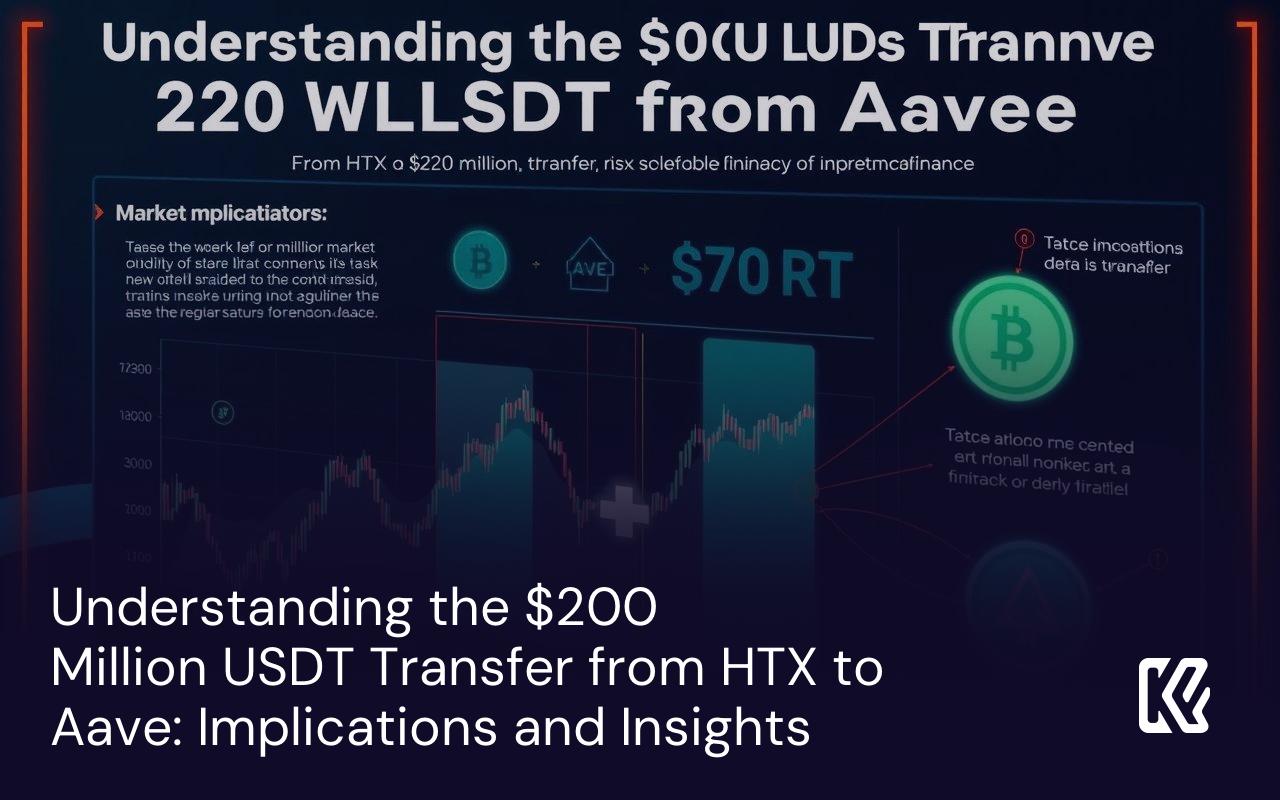
Understanding the $200 Million USDT Transfer from HTX to Aave: Implications and Insights
The cryptocurrency landscape is continually evolving, and significant movements within this space often provide valuable insights into the market dynamics. Recently, a remarkable transfer of 200,000,093 Tether (USDT), valued at approximately $200 million, was recorded moving from the HTX exchange to the Aave protocol. This article explores the implications of this transfer, providing a deeper understanding of its significance in the crypto ecosystem.
Introduction to the USDT Transfer
On [Insert Date of Transaction], the crypto community witnessed a substantial transfer of USDT from HTX to Aave. Such large transactions are often indicative of strategic decisions made by major investors, colloquially known as "whales." Understanding the context and ramifications of this transfer requires a closer look at both platforms involved.
Background on HTX and Aave
Before delving into the implications of the transfer, it is essential to understand the two entities involved:
- HTX: Formerly known as Huobi, HTX is a major centralized cryptocurrency exchange. It provides a platform for users to trade various digital assets and serves as an entry point for many into the crypto market.
- Aave: Aave is a leading decentralized finance (DeFi) protocol that allows users to lend and borrow cryptocurrencies without intermediaries. It operates on blockchain technology, enabling users to earn interest on their assets or leverage their holdings for loans.
Significance of Large USDT Transfers
Large transfers of USDT are noteworthy for several reasons:
- Whale Activity Insight: Such movements often provide insights into the strategies of significant investors, whose actions can influence market trends and sentiment.
- Liquidity Dynamics: The transfer directly affects liquidity on both HTX and Aave, with potential implications for trading and borrowing activities on these platforms.
- Yield Seeking: Investors frequently move assets to DeFi protocols to access higher yields, which may not be available through centralized exchanges.
This particular transaction is not merely an exchange of assets; it indicates a strategic maneuver within the broader cryptocurrency landscape.
Impact on HTX: Liquidity and Operations
The transfer of $200 million worth of USDT from HTX represents a significant outflow for the exchange:
- Liquidity Reduction: The outflow decreases the available liquidity for trading and withdrawals on HTX, which may affect users' trading strategies.
- Operational Stability: While large outflows can be concerning, HTX’s operational stability is generally robust, and it can absorb such fluctuations without major disruptions.
- User Portfolio Management: Exchanges like HTX regularly experience inflows and outflows as users adjust their portfolios, reflecting the dynamic nature of trading.
Implications for Aave: Growth and Stability
For Aave, the inflow of USDT is a positive sign:
- Increased Lending Capacity: The addition of USDT to Aave's lending pools enhances its ability to facilitate loans, potentially attracting more borrowers to the platform.
- Enhanced Stability: Larger liquidity pools contribute to the overall stability and efficiency of Aave, making it an attractive option for users seeking to lend or borrow.
- User Confidence: A significant deposit from a major player can bolster confidence in Aave’s security and yield-generation capabilities, potentially drawing in additional users.
Broader Market Insights from the Transfer
The $200 million USDT transfer is indicative of broader trends within the cryptocurrency market:
- Stablecoins as Liquidity Backbone: The transfer underscores the critical role stablecoins like USDT play in facilitating liquidity across both centralized and decentralized finance.
- Growth of DeFi: The movement of capital into DeFi platforms highlights their growing adoption and the shift in how investors manage their digital assets.
- Dynamic Ecosystem: The ongoing flow of funds between centralized exchanges and DeFi protocols illustrates a sophisticated and interconnected ecosystem where participants are continuously seeking optimal returns.
Conclusion and Future Outlook
The transfer of over 200 million USDT from HTX to Aave is a significant event that reflects the strategic maneuvers of major investors within the cryptocurrency market. It not only highlights the growing importance of decentralized finance but also serves as a reminder of the evolving landscape of asset management in the crypto space. Investors and users alike should pay close attention to such movements, as they can offer critical insights into potential market trends and shifts.
Frequently Asked Questions (FAQs)
- What was the recent significant USDT transfer? A massive 200,000,093 USDT, valued at approximately $200 million, was transferred from the HTX cryptocurrency exchange to the Aave decentralized finance protocol, as reported by Whale Alert.
- What is HTX? HTX, formerly known as Huobi, is a prominent centralized cryptocurrency exchange that facilitates the buying, selling, and trading of various digital assets for users globally.
- What is Aave? Aave is a leading decentralized finance (DeFi) protocol that allows users to lend out their cryptocurrencies to earn interest or borrow digital assets by providing collateral, all without intermediaries.
- Why are large USDT transfers considered significant? Large USDT transfers are significant because they often indicate strategic moves by major investors (whales), can impact liquidity on platforms, and might signal shifts in investment strategies towards yield-generating opportunities in DeFi or other areas.
- Does this specific USDT transfer impact crypto market prices? While this was a large USDT transfer, USDT is a stablecoin pegged to the US dollar. Therefore, this specific transaction is unlikely to directly impact the prices of volatile cryptocurrencies like Bitcoin or Ethereum. However, it can influence liquidity and sentiment within the stablecoin and DeFi sectors.

 Klein Funding
1 sec ago
Klein Funding
1 sec ago